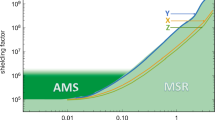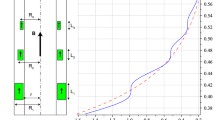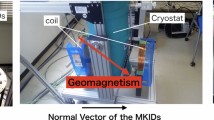Abstract
An improved functional approach for designing MRI (magnetic resonance imaging) main magnets with active shielding is presented. By nulling one or two external moments as well as a certain series of internal moments of the magnetic field, new designs with improved shielding in combination with or without shorter magnet lengths are obtained. The improved method can be employed to design short and practical superconducting magnets at any given field strength. The resulting designs yield the desired field homogeneity inside the region of interest without using superconducting shim coils. This approach requires only a modest amount of computing power. One of the design steps, a contour plot of the continuous current solutions, can be utilized to study stretch goals for favorable design parameters.
















Similar content being viewed by others
References
Morrow G (2000) Progress in MRI magnets. IEEE Trans. Appl Supercon 10:744–751
DeMeester G, Morich M, Byrne A, Davies F, Melotte D, Thomas A (2002) Challenges of short magnet design. Magn Res Mat Phys Bio Med 13:193–198
Kalafala AK (1990) A design approach for actively shielded magnetic resonance imaging magnets. IEEE Trans Magn 26:1181–1188
Kalafala AK (1991) Optimized configurations for actively shielded magnetic resonance imaging magnets. IEEE Trans Magn 27:1696–1699
Thompson MR, Brown RW, Srivastava VC (1994) An inverse approach to the design of MRI main magnets. IEEE Trans Magn 30:108–112
Brown RW, Fujita H, Shvartsman SM, Thompson MR, Morich MA, Petropoulos LS, Srivastava VC (1998) New applications of inverse methods in the design of MRI coils. Int J Appl Electromagn Mech 9:277–290
Crozier S, Doddrell DM (1997) Compact MRI magnet design by stochastic optimization. J Magn Res 127:233–237
Crozier S and Doddrell DM. Magnets for magnetic resonance systems. US Patent 5,818,319, (1998)
Zhao H, Crozier S, Doddrell DM (2000) A hybrid, inverse approach to the design of magnetic resonance imaging magnets. Med. Phys 27:599–607
Zhao H, Crozier S, Doddrell DM (2001) Compact clinical MRI magnet design using a multi-layer current density approach. Magn Res Med 45:331–340
Crozier S, Zhao H, Doddrell DM (2002) Current density mapping approach for design of clinical magnetic resonance imaging magnets. Concepts in Magn Res 15: 208–215
Ansorge RE, Carpenter TA, Hall LD, Shaw NR, Williams GB(2000) Use of parallel supercomputing to design magnetic resonance systems. IEEE Trans Appl Supercon 10:1368–1371
Shaw NR, Ansorge RE (2002) Genetic algorithms for MRI magnet design. IEEE Trans. Appl. Supercon. 12:733–736
Smythe WR (1950) Static and dynamic electricity. McGraw-Hill, New York, p. 275
Press WH, Flannery BP, Teukolsky SA, Vetterling WT (1992) Numerical recipes in fortran: the art of scientific computing. Cambridge University Press, New York:
Wilson MN (1983) Superconducting magnets. Oxford University Press, New York
Iwasa Y (1994) Case studies in superconducting magnets: design and operational issues. Plenum, New York
Van Sciver SW, Marken KR (2002) Superconducting magnets above 20 Tesla. Physics Today 55: 37–43
Palkovich A, Bird JM, Morad R (1991) Integrated active shielded magnet system. US Patent 5,012,217,
Brown RW, Shvartsman ShM (1999) Supershielding: confinement of magnetic and electric fields. Phys Rev Lett 83:1946–1949
Acknowledgements
We thank the following people who have provided many useful discussions in the design of main magnets: Roger Efferson and Roger Wheatley at American Magnetics, Gordon DeMeester and Vishnu Srivastava at Philips Medical Systems, Stuart Crozier at University of Queensland, Australia, and Nick Shaw at University of Cambridge, England. This research is supported by NIH R21 RR15211–01.
Author information
Authors and Affiliations
Corresponding author
Rights and permissions
About this article
Cite this article
Cheng, YC.N., Eagan, T.P., Brown, R.W. et al. Design of actively shielded main magnets: an improved functional method. Magn Reson Mater Phy 16, 57–67 (2003). https://doi.org/10.1007/s10334-003-0012-x
Received:
Accepted:
Published:
Issue Date:
DOI: https://doi.org/10.1007/s10334-003-0012-x




